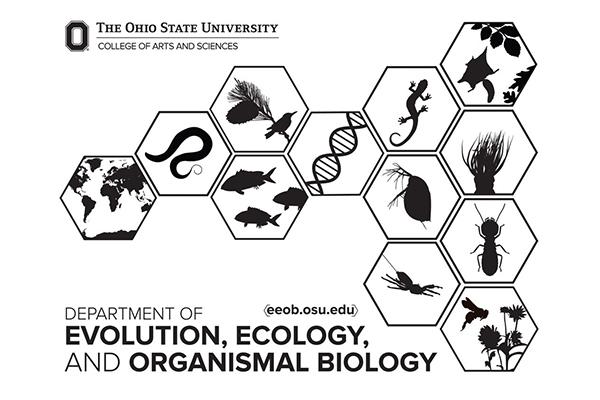EEOB Publications November 1 - November 30

Identification and expression of chemosensory receptor genes in the egg parasitoid Trissolcus basalis
Huayan Chen, Zachary Lahey, Elijah J. Talamas, Norman F. Johnson. 2020. https://doi.org/10.1016/j.cbd.2020.100758
Abstract
Parasitic wasps largely rely on chemosenses to locate resources. Understanding the evolution of their chemoreceptors can help elucidate the mechanisms underlying host adaptation and speciation. Trissolcus basalis is a biological control agent of the southern green stink bug, a pantropical pest, and is ideal for investigating the evolution of chemoreceptors. We identified 34 gustatory receptors, 170 odorant receptors, one odorant co-receptor, and 23 ionotropic receptors. Comparison with other Hymenoptera revealed species-specific expansions of 21 Grs and 53 Ors. Most of these Or expansions have 9 exons. Gender- and tissue-specific analyses showed that 5 Grs and 54 Ors are expressed only in antennae in both sexes, 66 Ors in female antennae only, and 4 Ors in male antennae alone. The identification and expression profile of chemosensory receptor genes in T. basalis helps in understanding the link between the evolution of chemoreceptors and speciation in parasitic wasps.
Variability of arbuscular mycorrhizal fungal communities within the root systems of individual plants is high and influenced by host species and root phosphorus
C. Deveautour, S. Donn, A.E. Bennett, S. Power, J.R. Powell. Pedobiologia, Volume 84,2021, 150691, ISSN 0031-4056. https://doi.org/10.1016/j.pedobi.2020.150691.
Abstract
The spatial distribution of arbuscular mycorrhizal (AM) fungal communities has been studied at many scales, from global to local, but few studies have explored variation within the root system of individual plants. Spatial variation within root systems might be expected partly due to differences in the physiology, morphology and anatomy of different roots, as well as due to spatial variation in the composition of inoculum in soil. Here, we assessed AM fungal community variability at various local scales: within individual plant root systems and among plants separated by distances of a few centimetres to up to several metres. To do so, we sampled roots from four plant species (two grasses and two forbs) growing in a grassland experiencing experimentally altered rainfall patterns in replicated field plots. We found that AM fungal communities were highly dissimilar both within the same individual and among different plants. Communities sampled within the same root system were as dissimilar as those sampled from adjacent neighbours, but less dissimilar from those sampled at larger distances. The degree of within root system variability was as high for each watering treatment but varied among plant species in a way that was dependent on root phosphorus content. Overall, our results show that community dissimilarity levels are high even within the root systems of individual plants, possibly due to localised community assembly processes (e.g., priority effects and interactions among AM fungal species), but that the degree of homogenisation within a root system is partly dependent on host plant attributes.
Water warming increases aggression in a tropical fish
Zi Xun Kua, Ian M. Hamilton, Allison L. McLaughlin, Reed M. Brodnik, S. Conor Keitzer, Jake Gilliland, Elizabeth A. Hoskins & Stuart A. Ludsin. Sci Rep 10, 20107 (2020).
https://doi.org/10.1038/s41598-020-76780-1
Abstract
Our understanding of how projected climatic warming will influence the world’s biota remains largely speculative, owing to the many ways in which it can directly and indirectly affect individual phenotypes. Its impact is expected to be especially severe in the tropics, where organisms have evolved in more physically stable conditions relative to temperate ecosystems. Lake Tanganyika (eastern Africa) is one ecosystem experiencing rapid warming, yet our understanding of how its diverse assemblage of endemic species will respond is incomplete. Herein, we conducted a laboratory experiment to assess how anticipated future warming would affect the mirror-elicited aggressive behaviour of Julidochromis ornatus, a common endemic cichlid in Lake Tanganyika. Given linkages that have been established between temperature and individual behaviour in fish and other animals, we hypothesized that water warming would heighten average individual aggression. Our findings support this hypothesis, suggesting the potential for water warming to mediate behavioural phenotypic expression through negative effects associated with individual health (body condition). We ultimately discuss the implications of our findings for efforts aimed at understanding how continued climate warming will affect the ecology of Lake Tanganyika fishes and other tropical ectotherms.
